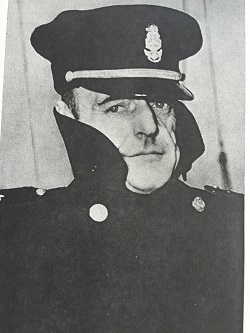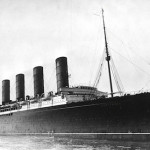The American freighter City of Flint was less than a day into its voyage from Scotland to New York Harbor on Sunday, Sept. 3, 1939, when a radio message relayed news that England and Germany were at war. The ship’s captain, Joseph Gainard, did not expect City of Flint to be a target of hostilities because America had declared its neutrality. But the state of war injected an element of uncertainty into an already stressful Atlantic crossing (see blog post City of Flint Odyssey, Part 1, Sept. 15, 2015).
In addition to its normal consignment of cargo, the ship carried 29 passengers as a favor to the U.S. Ambassador in London. To accommodate their guests, including nine women, Gainard and his crew had made several adjustments. The Shelter deck just below the Main deck had been converted into temporary passenger quarters for the men by securing cots to the decking. The women occupied separate facilities: four college girls in the captain’s quarters, three women in the chart room and two others in the chief officer’s cabin.
That evening, Gainard and many of the passengers were in the middle of a parlor game when the radio operator interrupted to hand him a message saying the British liner Athenia had been sunk. “In that crowded room everybody sensed that something had happened, but I didn’t want to explain things there,” Gainard later wrote.
He left the cabin and met with his officers on City of Flint’s bridge to explain they would go to the rescue of Athenia’s passengers. ”I explained we need not tell our passengers what ship had sent out the S.O.S. They had too many friends aboard her. There was no reason for them to worry any sooner than necessary.”
City of Flint changed course to intersect Athenia’s position then set about organizing the tasks that needed to be done during the 12 hours it would take to reach the sinking liner. Working through the night, the crew and passengers readied City of Flint to take on an indefinite number of wet, hungry people. The ship’s carpenter organized work crews to start building bunk beds on the Shelter deck. Roused from their beds, the chief cook and his assistant began making sandwiches along with pots of hot soup and coffee. One of the passengers told the captain he was a physician and psychiatrist and offered to help. Gainard put him in charge of the ship’s hospital. The ship’s lifeboats were made ready and swung out over the railing to help with rescue operations if needed.
The next morning, City of Flint reached the scene of the torpedoing to find that other vessels had arrived during the night to rescue some 1,300 people from lifeboats. Gainard took aboard 236 Athenia survivors from the luxury yacht Southern Cross. As survivors came aboard, crew members sent the injured, including one badly wounded 10-year-old girl, to the ship’s hospital. Those who were wet or soaked with oil received a warm blanket and dry clothing culled from the ship’s slop chest or donated by passengers, and assigned to a bunk. The crew made a concerted effort to record every new passenger’s name and where they were from to compile a comprehensive list of survivors aboard.
By 4 p.m. the transfer was complete and City of Flint continued its voyage westward. A ship unaccustomed to carrying any passengers now held 265 people bound for Canada and the United States. Given the ship’s crowded conditions and limited medical supplies, Gainard decided to head for the nearest landfall in North America – the port of Halifax in Nova Scotia. It would be a voyage of many happy memories and one sad note, as we will see in our next blog.





